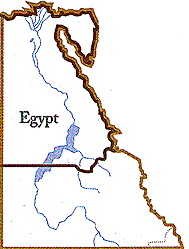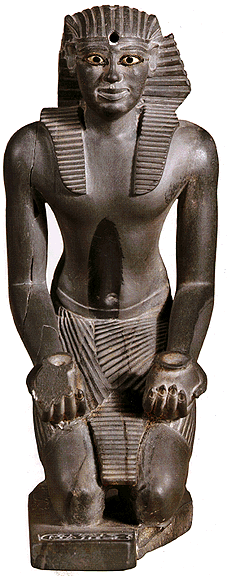
ANCIENT EGYPT AND NUBIA
The southern boundary of ancient Egypt at Aswan (the site of the modern High Dam) separated it from Nubia. In these adjacent sections of the lower Nile Valley, distinct ancient cultures can be traced in the archaeological record as far back as the fifth m
illennium b.c.
Primarily, these separate cultural identities, which persisted throughout antiquity, reflect the presence of different population groups, but Egypt and Nubia were also affected by important differences in their physical environments.

King Pepy I Making an Offering
Egypt, 6th Dynasty, reign of Pepy I, ca. 2289-2255 B.C. Graywacke (schist), 15.2 cm. high. The Brooklyn Museum, New York, Charles Edwin Wilbour Fund.
Egypt's part of the Nile Valley was far more fertile for agriculture; moreover, its location at the northeast corner of Africa gave it access, in addition to contacts with the south, to the rest of northern Africa and the Near East, and to goods and ideas that helped to stimulate its rise as one of the earliest great civilizations.
By about 4500 b.c., the inhabitants of that part of the Nile Valley had begun to develop, by continuous and gradually accelerating stages, a complex society based on the efficient management of land and other resources, sophisticated technical skills, and the beginnings of hieroglyphic writing. Shortly before 3000 b.c., this process culminated in the unification of the entire land under a single ruler, an event that the Egyptians considered the beginning of their dynastic history. For the next three thous and years, Egypt was to remain a major cultural-and often military-power. Today, we are still impressed by the rich legacy of this extraordinary civilization: huge structures, extensive written records, diverse artistic achievements, such as portraits car ved in stone, and spectacular goldwork.
Nubia's ancient past is more complicated than that of Egypt, and also less understood. Some of its cultures have left only scant traces in archaeological remains or in Egyptian records. Egypt was always very interested in Nubia, especially as a source of
trade, both for local products, such as gold, and for goods, such as ivory, brought from farther south. But despite Egypt's attempts to dominate and even control Nubia, several powerful cultures flourished in this area: the Kerma culture, the Napatan cult
ure-whose rulers conquered Egypt in the eighth century b.c. and ruled as the Twenty-fifth Dynasty-and its successor state, the second of Africa's great ancient civilizations, the kingdom of Meroë.
<- Back to the Main Index Page
<- To the Clickable Map of Africa ->
<-To Programs and Events in Conjunction with this Exhibition ->
![]()